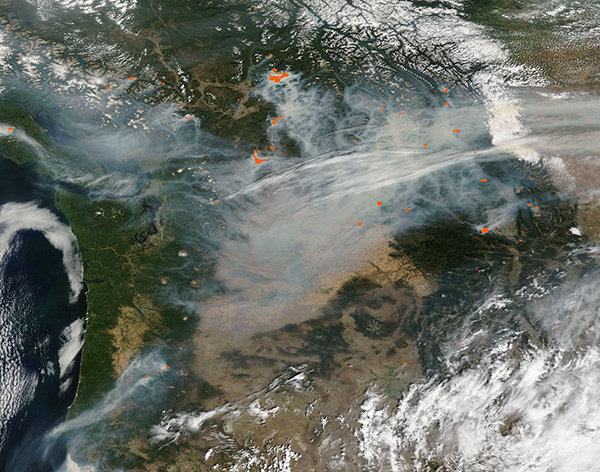Images
August 22, 2023 - Fires in Northwestern United States and Western Canada
Tweet
The western North American wildfire season continued to heat up through August 2023, with new fires breaking out in the state of Washington, United States and the province of British Columbia.
The Moderate Resolution Imaging Spectroradiometer (MODIS) on board NASA’s Terra satellite acquired a true-color image of fiery infernos in and swaths of brown smoke over the Western U.S. and Canada on August 19. The snow-covered mountains of British Columbia can be seen in the north. In the south, Washington’s green Cascades Mountains and tan Columbia River Basin are visible through a thick haze of smoke.
Numerous red “hot spots” mark actively burning fires in both regions, with the largest fire located in the Okanagan Valley, British Columbia. This rapidly expanding and erratic fire has threatened the town of Kelowna, where about 30,000 people were under evacuation orders on August 19. As of August 21, the British Columbia government’s EmergencyMapBC website reports 374 wildfires burning in the province. Of these, fourteen are “Fires of Note” (large or especially dangerous fires), 101 are “Under Control”, 144 are “Out of Control” and 115 are “Being Held”.
On August 18, one notable fire sparked in eastern Washington. Called the Gray Fire, the blaze began on the west sike of Medical Lake, about 15 miles (24 km) west of Spokane, and then rapidly expanded, driven by high wind. By August 21, the blaze had scorched 10,014 acres, according to the Washington State Department of Natural Resources. The fire was only 25 percent contained on that date, but higher humidity and less wind was moderating fire behavior and assisting firefighting efforts. The Associated Press (AP) reported that 185 structures had been destroyed and one person had died in the Gray Fire.
Image Facts
Satellite:
Terra
Date Acquired: 8/19/2023
Resolutions:
1km (347 KB), 500m (1.2 MB), 250m (3.7 MB)
Bands Used: 1,4,3
Image Credit:
MODIS Land Rapid Response Team, NASA GSFC
Tweet
The western North American wildfire season continued to heat up through August 2023, with new fires breaking out in the state of Washington, United States and the province of British Columbia.
The Moderate Resolution Imaging Spectroradiometer (MODIS) on board NASA’s Terra satellite acquired a true-color image of fiery infernos in and swaths of brown smoke over the Western U.S. and Canada on August 19. The snow-covered mountains of British Columbia can be seen in the north. In the south, Washington’s green Cascades Mountains and tan Columbia River Basin are visible through a thick haze of smoke.
Numerous red “hot spots” mark actively burning fires in both regions, with the largest fire located in the Okanagan Valley, British Columbia. This rapidly expanding and erratic fire has threatened the town of Kelowna, where about 30,000 people were under evacuation orders on August 19. As of August 21, the British Columbia government’s EmergencyMapBC website reports 374 wildfires burning in the province. Of these, fourteen are “Fires of Note” (large or especially dangerous fires), 101 are “Under Control”, 144 are “Out of Control” and 115 are “Being Held”.
On August 18, one notable fire sparked in eastern Washington. Called the Gray Fire, the blaze began on the west sike of Medical Lake, about 15 miles (24 km) west of Spokane, and then rapidly expanded, driven by high wind. By August 21, the blaze had scorched 10,014 acres, according to the Washington State Department of Natural Resources. The fire was only 25 percent contained on that date, but higher humidity and less wind was moderating fire behavior and assisting firefighting efforts. The Associated Press (AP) reported that 185 structures had been destroyed and one person had died in the Gray Fire.
Image Facts
Satellite:
Terra
Date Acquired: 8/19/2023
Resolutions:
1km (347 KB), 500m (1.2 MB), 250m (3.7 MB)
Bands Used: 1,4,3
Image Credit:
MODIS Land Rapid Response Team, NASA GSFC




